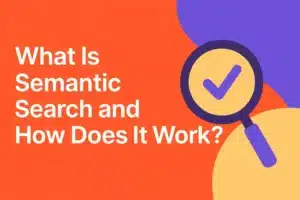Since Google launched AI Overviews in May 2024, we’ve witnessed a fundamental transformation in search behavior and website traffic patterns.
These AI-generated summaries now prominently appear at the top of search results, providing instant answers without requiring users to click through to websites. But what exactly does this mean for publishers, marketers, and everyday users?
Multiple research organizations have conducted extensive studies tracking the impacts of this technology over the past year.
Let’s dive into what these findings tell us about the current state of search and what we can expect going forward.
Key shifts revealed in major AI overviews studies
Zero click searches have now reached critical mass
The data is clear: zero-click searches (queries where users don’t click on any results) have exploded since AI Overviews launched.
SimilarWeb’s latest figures show that the percentage of news-related searches ending without a click to a news site jumped from 56% in May 2024 to a staggering 69% in May 2025 [NY Post].
This shift has devastating consequences for publishers. Organic traffic to news sites has plummeted from 2.3 billion visits in mid-2024 to under 1.7 billion in May 2025. Even more concerning, 37 of the top 50 news domains experienced year-over-year traffic declines following the introduction of AI Overviews [NY Post].
This isn’t just a problem for news publishers.
SparkToro found that over 58% of all Google searches now result in zero clicks, with users getting their information directly from the search results page [WordStream].
Google AI Overviews are replacing conventional snippets
Google’s rollout of AI Overviews marks the most disruptive change to search since featured snippets were introduced.
Unlike traditional snippets that pulled content directly from a single website, AI Overviews use Google’s Gemini language model to synthesize information from multiple high-authority sources into cohesive summaries [RankingEek].
The adoption of this feature has been remarkably swift. Semrush data shows that while only 6.49% of all queries triggered AI Overviews in January 2025, that figure more than doubled to 13.14% by March 2025 [Semrush].
These summaries typically appear as bullet points or short paragraphs at the top of search results, each with attribution links to original sources. But make no mistake, they’re designed to keep users on Google’s platform rather than sending them to individual websites.
User intent patterns are shifting with AI-led results
The way people interact with search is fundamentally changing. A comprehensive Pew Research study found that about 58% of respondents conducted at least one Google search in March 2025 that produced an AI-generated summary [Pew Research].
What’s fascinating is how these summaries affect user behavior. When AI Overviews appear, users are significantly less likely to click through to any websites. This shift is particularly pronounced for informational queries, which make up 88.1% of all searches triggering AI Overviews [Semrush].
Even more telling, the number of navigational queries (searches for specific websites or brands) that trigger AI Overviews doubled from January to March 2025, expanding from 0.74% to 1.43% [Semrush].
What publishers and marketers should learn from AI overviews
Search CTR is significantly falling across industries
The decline in click-through rates (CTR) is brutal and widespread. BrightEdge data reveals that CTRs have steadily declined, dropping nearly 30% since May 2024 [The AI Economy].
A separate study puts the impact even higher, finding that Google AI Overviews decrease CTRs by a whopping 34.5% [eMarketer].
This decline isn’t uniform across industries. Science (+22.27%), Health (+20.33%), People & Society (+18.83%), and Law & Government (+15.18%) are experiencing the largest growth in AI Overview appearances, suggesting these sectors face the steepest traffic challenges [Semrush].
Brand visibility now depends more on semantic authority
In this new landscape, your brand’s visibility depends less on traditional SEO metrics and more on what we might call “semantic authority” – how widely your brand is mentioned across the web.
A groundbreaking Ahrefs analysis of 75,000 brands revealed the factors that most influence AI Overview inclusion:
- Branded Web Mentions (0.664 correlation) – highest impact factor
- Branded Anchors (0.527) – hyperlinked brand mentions
- Branded Search Volume (0.392) – reflecting public interest
- Domain Rating (0.326) – website authority
- Number of Referring Domains (0.295) – backlink diversity
Shockingly, 26% of brands had zero mentions in AI Overviews [Nytro SEO].
Content recency also plays a crucial role.
A Seer Interactive study found that 65% of AI bot hits target content published in the past year, with 79% targeting content from the last two years. Only 6% of hits were on content older than six years [Seer Interactive].
New metadata optimization patterns are emerging
As AI Overviews become more prevalent, new optimization patterns are emerging.
The old SEO playbook focused on keywords and on-page elements is giving way to strategies that enhance semantic relevance and entity recognition.
Publishers now need to optimize not just for click-through but for inclusion in AI-generated summaries. This means structuring content to directly answer questions, using schema markup to clearly identify entities, and building broad topical authority rather than targeting individual keywords.
With informational queries making up 88.1% of all AI Overview triggers, creating comprehensive, factual content that answers user questions clearly has never been more important [Semrush].
Predictions drawn from consolidated AI overview trends
Zero click searches will surpass 75% of all queries
Based on current trends, zero-click searches are likely to surpass 75% of all queries by the end of 2026. We’ve already seen general search referral traffic to 1,000 web domains drop from 12 billion global visits in June 2024 to 11.2 billion in June 2025 – a 6.7% decline year over year [Digiday].
The percentage of queries triggering Google AI Overviews seems to have plateaued at around 19.88% as of May 2025, but this doesn’t tell the whole story [Digiday]. Other data shows that users are 50% less likely to click on links when an AI Overview appears [Mashable].
With Google’s continued refinement of its AI capabilities and users growing more comfortable with AI-generated answers, the zero-click trend will only accelerate.
Google AI Overviews will get source transparency upgrades
As scrutiny from publishers and regulators intensifies, Google will likely enhance transparency around how sources are selected for AI Overviews. Currently, AI Overviews can match one or more webpages from the top 10 Google organic search results 99.5% of the time [ResultFirst].
However, only 52% of the sources mentioned by Google AI Overviews typically rank in the top 10 results [ResultFirst].
This discrepancy has raised questions about source selection criteria.
We predict Google will introduce more robust source attribution, possibly including visibility into how frequently a source is cited and clearer indicators of information provenance to build trust with both users and content creators.
Affiliate and eCommerce publishers will face ranking restraints
Affiliate and eCommerce publishers are particularly vulnerable in this new landscape. Prior to AI Overviews, publishers could expect around a 4% click-through rate from an organic Google search placement.
Now, organic click-through drops to just 0.6% from an AI Overview [WARC].
This decline is having real impacts. Traffic to the world’s 500 most visited publishers has dropped 27% year-on-year since February 2024, an average loss of 64 million visits per month according to Similarweb data.
Major publishers like The New York Times (-4.81%), The Guardian (-3.28%), and CNBC (-20.92%) have all experienced significant year-on-year losses [The Current].
As Google continues to refine its AI capabilities, we expect further restrictions on affiliate content in search results, with a growing preference for first-party commerce experiences.
Conclusion
The AI overviews study data paints a clear picture: we’re witnessing a fundamental restructuring of the search landscape. Zero-click searches have reached critical mass, with users increasingly getting information directly from AI-generated summaries rather than visiting websites.
Click-through rates are plummeting across industries, forcing publishers and marketers to rethink their digital strategies.
Success in this new environment requires building semantic authority across the web, creating genuinely helpful content that answers user questions directly, and diversifying traffic sources beyond organic search.
While challenging, these changes also create opportunities for brands willing to adapt their approaches to match how people actually discover information in the AI era.
FAQs
How is Google AI Overviews impacting zero click searches?
Google AI Overviews are dramatically accelerating zero-click searches. Studies show that when an AI Overview appears, users are 50% less likely to click on any search result links. The percentage of news-related searches ending without clicks jumped from 56% to 69% in just one year after AI Overviews launched. This trend is expected to continue, with zero-click searches potentially exceeding 75% of all queries within the next year.
What does the ai overviews study mean for search marketers?
The ai overviews study reveals that search marketers must adapt their strategies significantly. Traditional SEO metrics like rankings and on-page optimization are becoming less important than building broad semantic authority across the web. Marketers should focus on generating branded mentions across multiple sites, creating comprehensive, factual content that directly answers user questions, and keeping content fresh, as 79% of AI Overview sources are from content published in the last two years.
Are content strategies shifting due to AI-led results?
Absolutely. Content strategies are undergoing a major transformation in response to AI-led results. Publishers are now optimizing not just for clicks but for inclusion in AI summaries. This means creating more structured, factual content that directly answers specific questions. There’s also growing emphasis on establishing topic authority rather than keyword targeting, and ensuring content stays fresh and updated, as AI systems show strong preference for recent information. Many publishers are also diversifying beyond search traffic to reduce dependence on Google.



